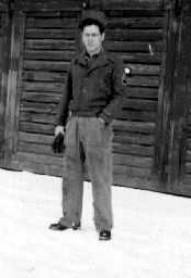
William Blystone –Neubiberg,Germany 1945
Interview with 357th FG member, William Blystone
Conducted by Mr. Darrell Reel – DR: – Darrell Reel, WB: – William Blystone (Crew Chief with the 82nd Fighter Squadron, 78th Fighter Group, 8th Air Force and 362nd Fighter Squadron, 357th Fighter Group, 8th Air Force)
DR: What did you do before the war?
WB: I graduated from High School in 1940, loafed until I was 18 years old then went into coal mines working with my father. War was declared Dec 8 1941 and I enlisted in army on 16 Dec 1941.
DR: Would you give me some bio information on your war years?
WB: I was in the 78th Fighter Group, 82nd Fighter Squadron from early 1942 until we lost our P38s to North Africa in early 1943. I transferred to a Fighter Training Squadron crewing P-47s. I joined the 82nd at North Island Naval Station in San Diego, CA after attending aircraft maintenance school in Keesler Field, MS. and Lockheed factory school in Burbank,CA.. I was an aircraft mechanic. The Group left California in late 1942 and after a troop train ride across the US we boarded the Queen Elizabeth and with 15,000 other troops we sailed for England arriving around 27 Nov. 1942. We went To Goxhill Airfield near Grimsby and with our P-38s practiced escort duty with a local B17 Bomber Group. Our planes were then sent with pilots into North Africa and we were without planes for a short while. Some of us mechanics were sent to RAF schools for various training. I was at a Mobile oxygen producing school for a month but never saw another mobile unit during my entire time in England. We got P-47s then and after a short time the Group was sent to a new station at Duxford, near Cambridge. I transferred to a fighter training squadron at Atcham airfield near Shrewsbury, where we gave training in P-47s to new pilots, mainly the Eagle Squadron pilots who were transferring from the RAF to the American 8th Air Force. I was there a year or so and then went back to Goxhill crewing P38s again in the training outfit. After a few months our outfit was sent to Leiston Airfield to the 357th Fighter Group where we worked on P51 Mustangs. I was in the 362nd Fighter Squadron as a crew chief. I went into Germany with the Group after the war ended in Europe and pulled occupation duty for about 7 months during which time I got the job of crewing a C-47 Gooney Bird for a couple months flying as engineer. I left the unit in March 1946 and was discharged from the service and went back to my home in Pennsylvania. I had been away from home from December 1941 until March 1946 and hadn’t seen my parents during that time. That’s about it.
DR: Do you remember the names of the planes and the pilots whose planes you worked on? If so, could you tell me the names of the planes and the pilots of those planes?
WB: Sorry, the only plane I had for a spell was named for my wife, Jessie. The others were just numbers mostly and some were War Weary aircraft that were used after completing their combat and were given to us in the training units to use for training pilots. Many still had the names that were on them when they were in combat and we didn’t change that. I had a couple regular pilots then, but can’t remember their names. I had numerous new pilots that flew training flights in A/C I crewed, but I don’t remember their names. After all that was over 55 years ago and I’m now 78 years old.
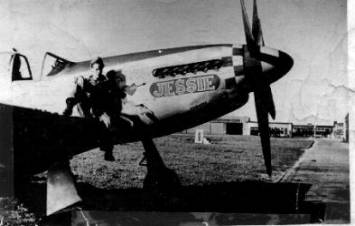
William Blystone’s plane, “Jessie”, – Mr. Blystone on the wing.
DR: Did “Jessie” have the same name on both sides of the plane, or just a name on the right? Do you remember the tail numbers, or did they remove all numbers and just leave the “WW” on the vertical stabilizers?
WB: The name “Jessie” was on both sides of the plane. I had another that I remember now called “Snake Eyes”. It had a pair of dice with 1 dot on each to make a total of 2, which was snake eyes if you tossed the dice. I didn’t play dice, but used to watch a few of the other guys losing their money. We got paid once a month and usually had some plans to go to town if we could and spend some of it. After getting into a crap game, many changed their mind about going to town because they lost all their money and would have to borrow, or wait until the next payday. The War Weary aircraft still retained their original names and numbers, at least the serial numbers if I remember correctly and most still had their D-Day markings of white and black bands on the fuselage and wings if they lasted that long.
DR: I am a bit confused. I thought you were a crew chief, responsible for the maintenance of the planes. Did you also fly, or did you train the new pilots on the functioning of the plane? You say you had your own plane and I thought only pilots had their own plane. Like I said, I am a bit confused and I could use some clarification.
WB: I was a mechanic crew chief, however I also was on flying status as engineer on the C47 we had assigned to the 357th Group when we were in the Occupation airforce in Germany late 1945 into 1946. I was only on flight status for a short while and got off of it shortly before the C47 was taken over by another crew chief, which was fortunate for me as the plane crashed into a mountain and all aboard were killed later on. In early 1943 until Feb. 1944, I was in the 495th Fighter Training group at Atcham Airfield near Shrewsbury, England. I crewed P-47 Thunderbolts there and as the planes were used for training and had no assigned pilots, the crew chiefs could name their own planes as they wished, if the CO concurred. In Feb. 1944, I was assigned to the 496th Fighter Training Group, 554th Fighter Training Squadron at Goxhill near Grimsby, England. I then crewed P-38s again and as it was a training base, we could name our own planes, as they were not assigned to any pilot. I named my P-38 “SlipStream Sally” and it was featured in my hometown paper in Pennsylvania along with a write up about me. In Dec. 1944, our unit left Goxhill and was attached to the 362nd Fighter Squadron, 357th Fighter Group, at Leiston, England to crew P-51s. We were given the War Weary aircraft that were deemed no longer combat ready by the group, for use in training new pilots that were assigned to the group. These planes had seen better days, but we kept them flying. They still had their names that were given to them by their pilots and crew chiefs, but there was a big WW painted on the vertical stabilizers so they could be seen as training aircraft. This training unit I was in was called “Clobber College” and had write ups in the Stars and Stripes and Yank magazine, military publications put out by the army. We had a logo of a duck on crutches with a bandaged head as our unit identification. Our group gave training to many of the newly assigned pilots that later went into combat with the regular squadrons. We were assigned instead of attached to the 362nd I think in April 1945 and I was with them when we were assigned to Germany until I went Stateside for discharge. In Germany I can’t remember any assigned pilots to the aircraft. I know the planes I worked on there were flown by various pilots and we could name the planes we were assigned as we saw fit. I hope this straightens some things out for you. Many crew chiefs named their planes back then, although assigned pilots had first choice.
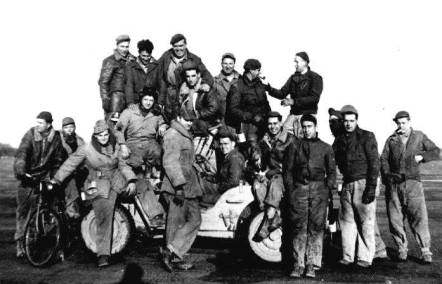
Clobber College Mechanics: Leiston 1945 Names on back of picture were as follows: Front row left to right McLain on bike, Zaluski, Grau, Parks, Fagan driving jeep, Sedgwick, Parlette, Traber, Antonio, and Cripe smoking cigarette Back row left to right: Blystone, Hitchens, Konier, Nardizzi, Swartz, Bellusci,and Aiken
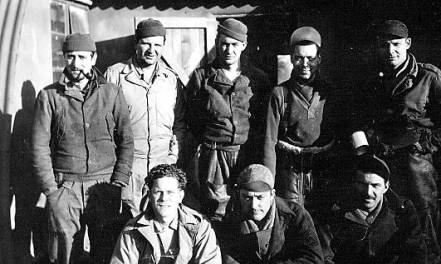
More Clobber College mechanics, Leiston 1945 Back row left to right: Bellusci, Swartz, Hartley, Antonia, and Parks Front row left to right: Sawyer, Shipley, Cirlincione
DR: You mentioned the “Clobber College”, could you tell me more about the function of that group and what your day to day routine involved?
WB: At Clobber College all we did was work from daylight until nightfall, unless we had a flight in the air, or we had to work at night to do some extra maintenance to get a plane flyable.
DR: What did you men do to train the pilots in the “Clobber College”?
WB: Our men only maintained the aircraft at Clobber College. The pilots using our planes were already assigned to units in the 357th Group and the squadrons were the ones who actually did the transition training. We didn’t have pilots assigned to the Clobber College although we did have an officer assigned as Maintenance officer. I can’t remember his name.
DR: Did you have any other functions with the 357th Fighter Group?
WB: Only as a mechanic, although I had a crew putting all the P51s in storage at Neubiberg, in early 1946. Pilots and mechanics were few and far between shortly after we went to Germany; everybody except some of us diehards had gone home.
DR: To whom did you report?
WB: I reported to my CO, Major Carson, or to the first sergeant of the 362nd, to which we were attached
DR: Do you remember the A-20’s flown at the “Clobber College” to tow targets? Could you give any details about them?
WB: I never saw any A-20s at Leiston. Did I miss something? They may have flown from another field.
DR: You say you do not remember the names of the planes you worked on, other than “Jessie”. Do you remember any of the numbers?
WB: I don’t remember any a/c numbers.
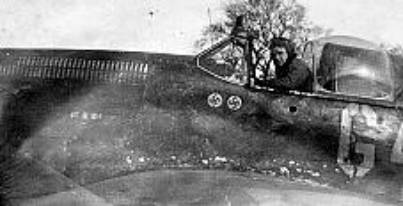
Ted Fagan in “Man 0f War”, 1944
Ted was our radioman. Aircraft was War Weary “Man of War”, still flyable and used to give new pilot’s transition before actual combat flying
DR: According to my understanding, you worked with the P38, P47 and P51 in the various Fighter Groups you belonged to, could you tell me how the 3 compared to work on?
WB: The P38 was the hardest to work on, as it had two engines and lots of exhaust turbo supercharger problems at times. The P47 was the easiest and P-51 in between. None were too hard to maintain.
DR: Were any models of the P51 harder to work on than the others?
WB: I think all the P51 models were the same to work on by the plane mechanics. Maybe some radio and armament problems were different.
DR: How did weather impact your job?
WB: We worked in all kinds of weather, but of course when the planes didn’t fly we could also get some rest. Winter was hardest, as the cold affected the oil and also the feel of the airplane itself. I think it liked warmer weather as much as we did.
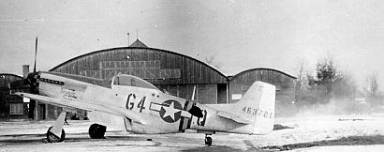
“Fragile Fran”, Neubiberg 1945-6
That’s me again in the snow and wind. Got cold down there near the Alps mountains
DR: Did you ever come under fire, while you were with the 357th?
WB: Never came under fire with the 357th, but was in a few air raids during the 1943-44 period. In London, or some of its suburbs, where we usually went when we had some time off for a few days, which was few and far between.
DR: You met your wife, (who served on an English AAA unit), while serving at Leiston. How did that take place?
WB: Met Jessie one night at a pub. We were all playing 21, a form of Black Jack for pennies. There wasn’t much to do around Leiston in the evenings.
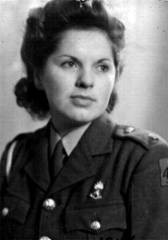
This is my wife Jessie – she was in the British Army in an antiaircraft gun battery. She was stationed near our airfield in Leiston. She’s the one I named my P-51 after. We’ve been married 56 years now.
DR: Do you recall any funny, or memorable incidents while serving with the 357th FG?
WB: Saw Otto Jenkins buzz the field on his final mission and crash the plane. He was too low.
DR: What do you remember of D-Day and what were you doing on that day?
WB: On D-Day 1944, I was still in Goxhill crewing “Slip Stream Sally”. All we did was put on the D-Day markings of white and black stripes on the planes, or rather our maintenance unit did,I didn’t. Our planes as far as I know, didn’t participate in the battles that day.
DR: What functions did the C47 you were an engineer on, perform?
WB: The C47 we had was used mostly for liquor runs and trips to various places for rest and relaxation. We flew to France, London, and Brussels and down to the Riviera. I quit crewing the plane before it crashed in the Alps in October 1945, while on a trip to the seashore near Nice, France. Most of the passengers were officers and I think 3 Red Cross ladies, as well as the plane crew. The plane wasn’t found for a few days, as it was buried in the snow when it hit the mountain.
DR: What type of training for your position did you have and do you feel you were well prepared for your functions?
WB: I went to airplane mechanic school at Keesler Field, Mississippi and then to Lockheed factory school at Burbank, CA., before reporting to North Island Naval Air Station in San Diego to join the 82nd Fighter Squadron. They started me off right away as an assistant crew chief and I made Corporal in July 1942 as I remember. I started to crew my own planes, then after we lost the P-38s to North Africa in early 1943, I went to a training squadron at Atcham.
DR: Looking back, how do you view your WWII experience now?
WB: The best years of my life were those 4 years during the war. Much better than working in the coal mines. I saw service after that until 1966, retiring as a Chief Warrant Officer. Served in Germany for 6 years after the war period, many places Stateside and only one year in Vietnam, in 1963-64. That’s about it.
Bill B
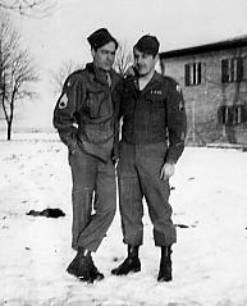
Sgts Blystone and Christenson 1945
Chris also married overseas. He was from Salt Lake, Utah. I last saw him at Ft. Sill, OK in 1950 when he came into the airfield with planes from Utah National Guard, I think they were getting ready to go to Korea at the time, they were still using P-51s. Chris died a couple years ago according to the news from the 357th Unit paper.
Thanks to Bill Blystone for this great interview and to Darrell Reel for conducting it for us!!

